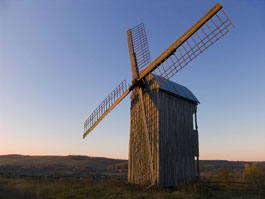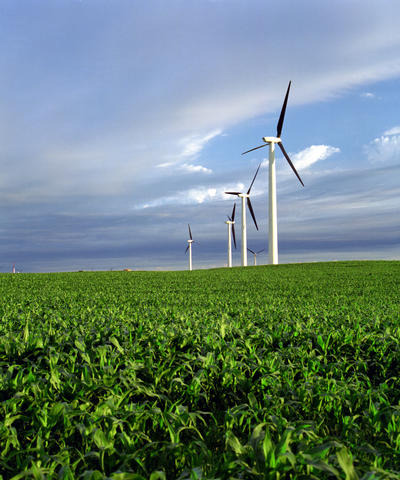People have been using wind energy for thousands of years
People used wind energy to propel boats along the Nile River as early as 5,000 BC. By 200 BC, simple wind-powered water pumps were used in China, and windmills with woven-reed blades were grinding grain in Persia and the Middle East.
New ways to use wind energy eventually spread around the world. By the 11th century, people in the Middle East were using wind pumps and windmills extensively for food production. Merchants and the Crusaders brought wind technology to Europe. The Dutch developed large windpumps to drain lakes and marshes in the Rhine River Delta. Immigrants from Europe eventually took wind energy technology to the Western Hemisphere.
American colonists used windmills to grind grain, pump water, and cut wood at sawmills. Homesteaders and ranchers installed thousands of wind pumps as they settled the western United States. In the late 1800s and early 1900s, small wind-electric generators (wind turbines) were also widely used.
The number of wind pumps and wind turbines declined as rural electrification programs in the 1930s extended power lines to most farms and ranches across the country. However, some ranches still use wind pumps to supply water for livestock. Small wind turbines are becoming more common again, mainly to supply electricity in remote and rural areas.
Wind energy use expanded in the wake of oil shortages and environmental concerns
The oil shortages of the 1970s changed the energy environment for the United States and the world. The oil shortages created an interest in developing ways to use alternative energy sources, such as wind energy, to generate electricity. The U.S. federal government supported research and development of large wind turbines. In the early 1980s, thousands of wind turbines were installed in California, largely because of federal and state policies that encouraged the use of renewable energy sources.
Beginning in the 1990s and continuing today, the U.S. federal government and state governments have established financial incentives and requirements to use renewable energy sources. The federal government has also provided research and development funding to help reduce the cost of wind turbines and offers tax and investment incentives for wind power projects. In addition, state governments have established minimum requirements for electricity generation from renewable sources, and electric power marketers and utilities may offer electricity generated from wind and other renewable energy sources (sometimes called green power) to their customers. These policies and programs have resulted in more wind turbines and more electricity generated from wind energy.
The share of U.S. electricity generation from wind energy has grown from less than 1% in 1990 to about 10.2% in 2022. Financial and other incentives for wind energy in Europe have resulted in a large expansion of wind energy use there. China has invested heavily in wind energy and is now the world's largest wind electricity generator. In 1990, 16 countries generated a total of about 3.6 billion kWh of wind electricity. In 2021, at least 128 countries (including Puerto Rico) generated about 1,808 billion kWh of wind electricity.
Last updated: April 20, 2023, with data available at the time of update.


